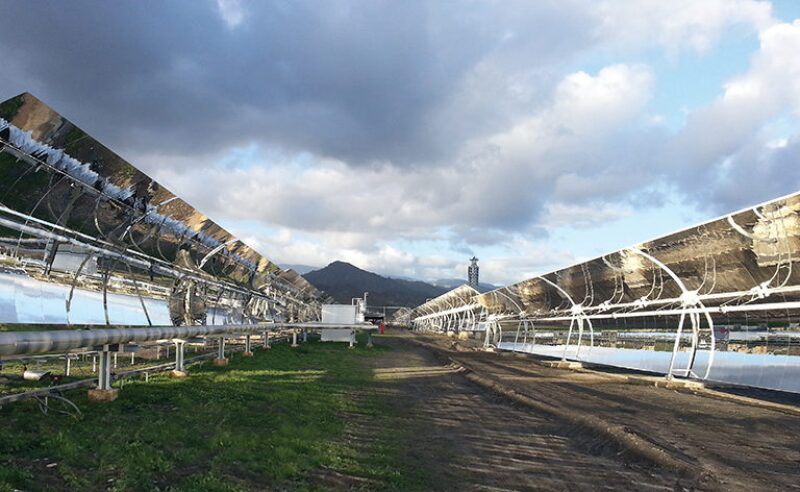German startup Solarlite is trying to do two things for oil companies: make steam, and make it cheap. Founded in 2004, the firm specializes in manufacturing concentrated solar power (CSP) systems that have mainly been used for small-scale electricity generation.
But that application is being squeezed by another solar energy technology, photovoltaics (PVs), and so the company is now looking at enhanced oil recovery (EOR) for its future business.
“The price of PVs has declined so dramatically that, at least for power generation, people question if CSP can actually survive,” said Steven Geiger, director of business development for Solarlite. “Our idea is to basically use the sun to produce heat, or steam in this case, and escape the competition from PVs.”
With CSP-for-EOR, the simple aim is to focus a beam of reflected sunlight onto insulated tubing that is full of water. As that water boils under the glare of solar radiation, the produced vapor is injected into a reservoir that requires a significant measure of heat (between 480°F and 520°F) to mobilize residual, and typically heavy, oil.
The concept is not new, but Solarlite’s version is different from what the upstream industry has seen before. The firm’s chief competitor, GlassPoint, was the first to pioneer CSP-for-EOR in Oman back in 2011 and remains the largest player in this space.
To carve out its own niche, what Solarlite wants to prove is that CSP can be done in the wide open. This is in contrast to GlassPoint’s approach, which uses large glass houses—hence the firm’s name—to protect the oscillating reflectors from wind and dust.
“However, you lose about 10% of the sunlight as its passes through the glass,” Geiger said, explaining that absorption and light-scattering are unavoidable in that setup. The key point he is making to prospective oilfield customers is that with regard to CSP-for-EOR, the name of the game is heat efficiency.
No Glass, No Problem
While Solarlite does not use glass houses, it does use ultrathin glass mirrors that it claims are about 10% more efficient than the metallic reflectors used by other CSP providers. And without the constraint of a glass house, Solarlite says it can spread its mirrors further apart to prevent them from casting shadows on each other, representing another 20% gain in heat efficiency.
Two of the primary drivers for using glass-protected CSP systems are dust and wind, factors that Solarlite also believes its technology addresses through alternative engineering routes.
Geiger explained that if a parabolic trough—the term used for the curved apparatus that is the most recognizable attribute of CSP—moves due to the wind, the reflective heat energy required to generate steam may lose its focus on the fluid tubing.
“We’ve overcome that because we use a composite that is about 1.5-in. thick,” he said, adding that the lightweight material is a rigid fiber-reinforced polymer. “It’s pretty much what you make a surfboard out of and has exceptional stability and rigidity.”
Five years of field operation at one of its CSP facilities in Spain has shown that these composite troughs can operate under wind conditions in excess of 40 mph. Solarlite has also carried out studies to show that dust may not be such a big issue after all.
“The bottom line is that it’s trivial and simple,” Geiger said of the dust concern. “You only have to clean the mirrors once a week, and then after every major sand storm.”
Under the worst conditions, Solarlite has determined that its mirrors may need up to 100 cleanings a year. But to lower the expense of this job, the firm is proposing the use of robots that can continuously move across each row of mirrors and spray off the dust with water or air.
Untapped Markets
By Solarlite’s estimation, 70% of the potential CSP-for-EOR market exists in only four areas of the world: Kuwait, Oman, Saudi Arabia, and California. These places all have heavy-oil production, lots of sunshine, and relatively expensive industrial natural gas—the fuel most used to generate steam for EOR.
In Kuwait, for instance, Geiger said that the country imports liquefied natural gas for about USD 8/MMBtu. That is not a bad price, but by the time it is regasified and piped to the field for EOR, he said the unit cost has soared to about USD 15/MMBtu.
By comparison, Solarlite thinks it can provide steam in Kuwait at a cost-equivalent of USD 3.50/MMBtu. Last year, Solarlite came close to establishing its first CSP-for-EOR plant in the country after winning an open tender, only to see the Kuwaiti government cancel it.
Geiger said another tender will be issued this year and that Solarlite will compete again with the same proposal, which came in lower than all other bids.
But aside from Kuwait, the company thinks it also has great potential to land contracts in California where as much as 18% of the state’s natural gas is burned to support steam-EOR operations.
Because of that state’s tax credits for renewable energy and expensive carbon credits, Geiger said in California “you could be getting your gas for free and it will still be cheaper to use solar steam for EOR.”


